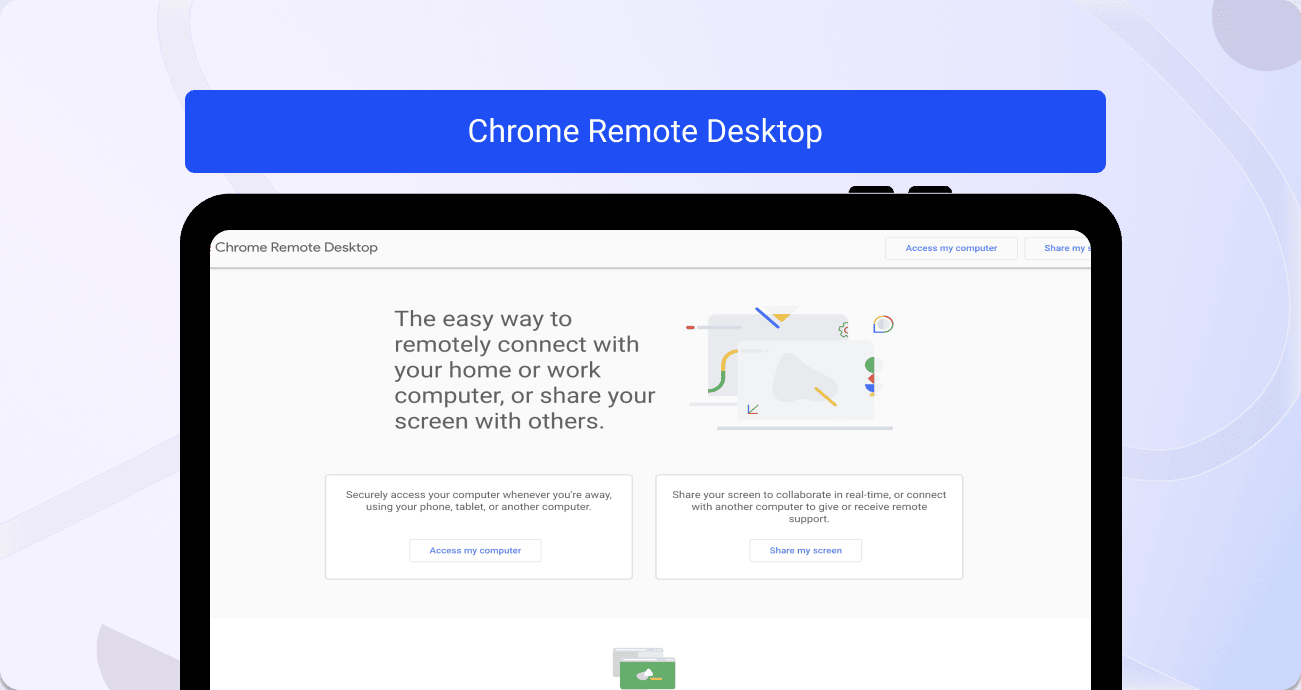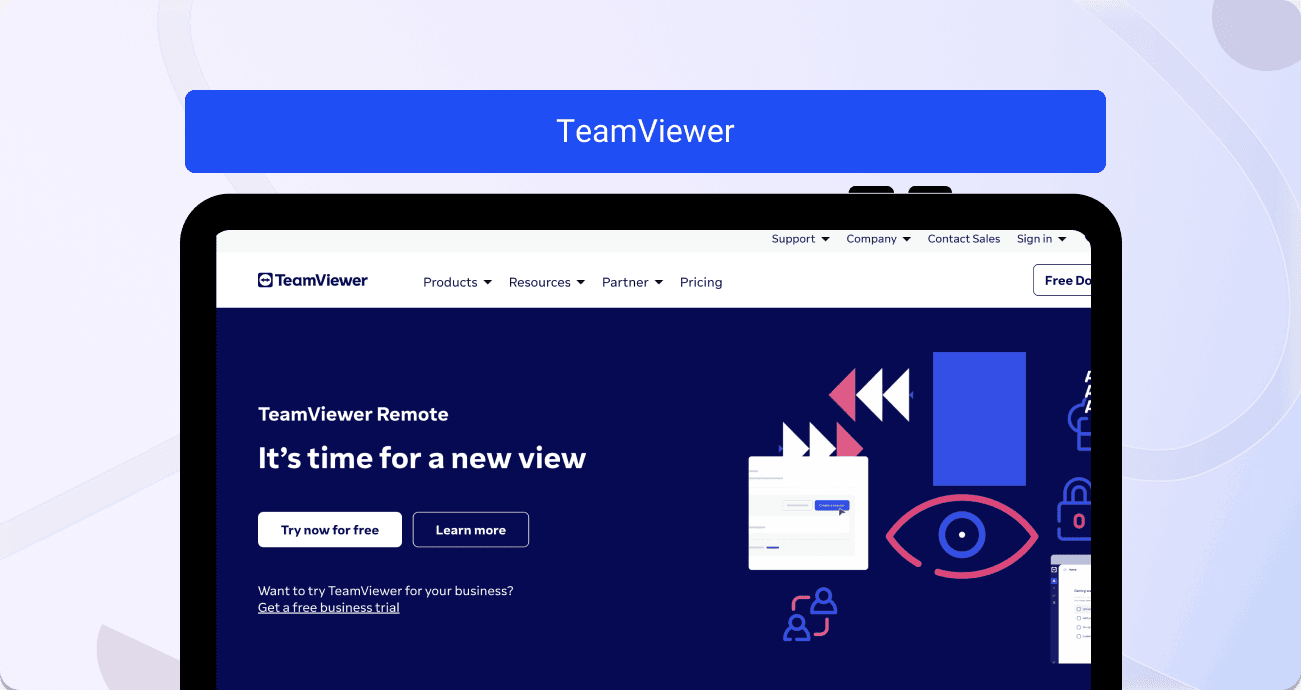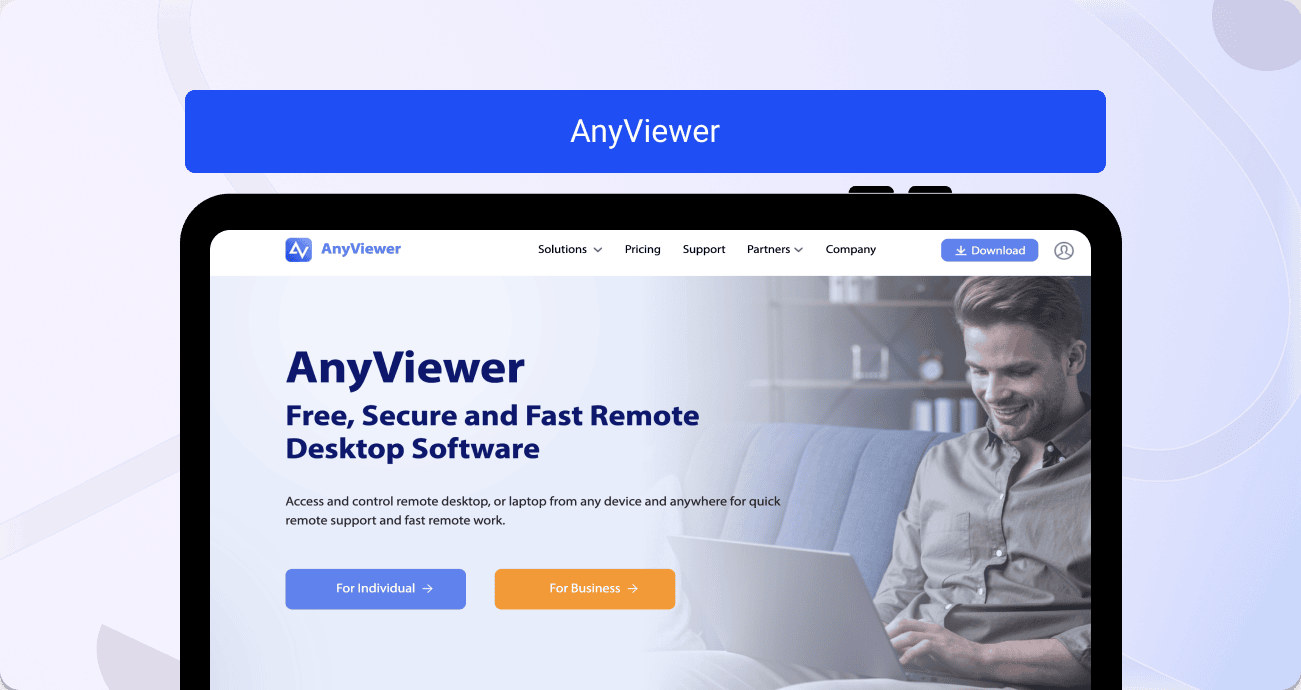Finding the best remote access software for your business can be a challenge. With so many options on the market, how can you be sure the service you’ve chosen will benefit you and, more importantly, your customers?
One of the most popular options on the market at the moment is Chrome Remote Desktop - but is it really all it’s made out to be?
Here, we’ll cover what Chrome Remote Desktop is, whether it’s worth the hype, and the alternatives you might be interested in pursuing instead.
If you’re looking for more information on exactly what remote access is or what co-browsing offers, you can follow these links.
Read on to find out more about the best Chrome Remote Desktop alternatives in 2023 and beyond.
What is Chrome Remote Desktop?

To kick things off, let’s take a look at exactly what Chrome Remote Desktop offers.
As a free service provided by Google, Chrome Remote Desktop is a remote desktop software which enables users to access other machines without being in their physical presence. This can be useful for accessing information you have saved on another device, or for collaborating with customers when they have a technical issue.
At its core, Chrome Remote Desktop is the most basic of the remote access softwares, offering the functionality to share screens and remotely control another machine.
This software effectively enables users to remotely ‘log in’ to another machine and take control of it - but it’s not without its risks.
Why use a Chrome Remote Desktop alternative?
As a popular service, you might be wondering why you would consider an alternative solution to Chrome Remote Desktop. We’ve got you covered.
Here are three big reasons you might consider an alternative service for your business.
Chrome Remote Desktop is a free service
Now, stay with us here - it’s not often you hear a free-of-charge product being criticized for its price point.
However, the timeless saying stands - you get what you pay for.
As you might expect with a free service, Chrome Remote Desktop does not offer the depth of functionality and quality that other paid softwares do. Whilst it’s a great starting point for smaller businesses or those looking for sporadic usage, if remote access is a service your business relies on, it’s worth investing in a higher-quality solution.
If you have the budget to spend, consider looking further afield for a service that will effectively meet your needs and not leave you wanting.
Chrome Remote Desktop is not suitable for customer support teams
As we hinted at above, if your business centers around customer support teams, Chrome Remote Desktop may not be the choice for you.
Whilst its remote access functionality is useful, it is very basic and doesn’t facilitate effective customer service at scale.
Chrome Remote Desktop does not benefit from either console logs or session replays, which can make troubleshooting and bug diagnosis a much bigger challenge for your agents. At its core, Chrome Remote Desktop offers nothing more than what your customer can already see on their screen.
If you rely on effective customer support within your business model, consider choosing a service that offers more in-depth, technical functionality.
Chrome Remote Desktop can be prone to remote access scams
Unfortunately, remote desktop software has long been prone to scams, and Chrome Remote Desktop is no different.
As Chrome Remote Desktop is free, it offers an attractive proposition for would-be scammers. If you are unlucky enough to connect with a scammer via this software, they will have full access to your machine and everything on it.
As always, there are preventative measures you can take to avoid remote access scams, such as not allowing access unless you are absolutely certain the other party is who they say they are. However, without data blurring and privacy functionality offered by other softwares, the risk is always there.
Best alternatives to Chrome Remote Desktop in 2023
So, if Chrome Remote Desktop isn’t the best solution for your business, what is?
We’ve compiled some of the top alternatives for you to consider, each with its own pros and cons.
Read on to find out more about the options available to you.
Alternative one - Fullview
Introducing Fullview, our first exploration into alternative software solutions.
Fullview's cobrowsing software stands as a versatile customer experience and technical support platform, empowering teams to enhance customer interactions. It excels in two key functions: cobrowsing and session replays.
Cobrowsing is different from traditional remote desktop software because it only allows agents access to specific pages, browser windows, or programs, rather than the entire machine. This approach ensures heightened security and privacy, with the added benefit of customizable data blurring to shield sensitive information.
The collaborative nature of cobrowsing facilitates issue diagnosis and solution identification without the inherent risks of conventional remote access methods. Seamless integration with widely used software such as Intercom, Zendesk, or Salesforce Service Cloud ensures convenient initiation of cobrowsing sessions.
Meanwhile, session replays prove invaluable for customer service agents. This feature enables agents to review users' interactions with a service, identifying pain points and potential bugs before they escalate. Robust filtering options empower agents to pinpoint specific session recordings swiftly.
Enhanced by console logs and customizable dashboards, Fullview simplifies the process of identifying bugs or errors. All the essential information is consolidated in an easily accessible interface, streamlining the retrieval of necessary insights.
Why Fullview is better than Chrome Remote Desktop
Choosing Fullview over Chrome Remote Desktop comes with a myriad of compelling reasons, which we'll delve into below.
Primarily, when catering to customer support teams, Fullview stands out as the superior choice, purposefully crafted to streamline effective customer support and enhance key metrics such as CSTA, FCR, and ART.
Fullview's functionality seamlessly aligns with the day-to-day operations of customer support teams. It encompasses cobrowsing, session replays, and console logs, providing an all-inclusive toolkit, while Chrome Remote Desktop focuses on a single main feature. Our new AI agent plugs into your app to deliver real-time, intelligent support. Unlike static bots, it understands your UI and interacts with it natively—executing clicks and inputs to help users. Developers can manage and fine-tune it via the AI Library, and extend its logic with human feedback for high-complexity workflows.
Usability is another strong suit of Fullview in comparison to Chrome Remote Desktop. Offering hassle-free installation, no downloads, and minimal latency, Fullview easily integrates with existing customer support software, ensuring unparalleled ease of use.
Security is a paramount advantage of Fullview, boasting 100% GDPR compliance, data blurring options, and a reduced risk of remote access scans. For those prioritizing customer security, Fullview emerges as the superior choice.
Moreover, if Chrome Remote Desktop's free pricing is a deciding factor, Fullview addresses this concern by offering a 'forever free' package alongside premium options. The paid choices encompass a Pro membership at €47 per month and an Enterprise package with a price on application (POA).
Alternative two - TeamViewer

Another alternative solution for your business could be TeamViewer. As one of the most widely recognized remote access softwares, TeamViewer has been installed on more than 2.5 billion devices around the world.
TeamViewer offers three main solutions - remote access and support for customer support teams, after-sales service solutions for sales teams, and vision-picking solutions for warehouse and logistics teams.
TeamViewer’s remote access software is one of the most popular on the market, and for good reason. With a 4.7/5 rating across more than 75,000 reviews, TeamViewer offers ease of use, reliability, and product training to equip your teams effectively.
Why TeamViewer is better than Chrome Remote Desktop
Opting for TeamViewer over Chrome Remote Desktop can be driven by various factors. Firstly, TeamViewer's distinguished brand and widespread reputation, backed by numerous global companies, provide a sense of reliability and experience.
A notable advantage of TeamViewer in comparison to Chrome Remote Desktop is its dual focus on both the support agent and the recipient of support. Unlike many remote access tools tailored predominantly to one party, TeamViewer's versatility makes it a user-friendly choice for both sides of the interaction.
TeamViewer's compatibility extends further by allowing integration with existing software systems such as Salesforce, Slack, Zendesk, and Microsoft Teams—a feature not available with Chrome Remote Desktop.
While TeamViewer offers a cost-effective solution, with a Remote Access package priced at approximately $20 per month and a Business package at around $45 per month, it's crucial to consider potential drawbacks. Like many remote access software, TeamViewer may be susceptible to scams, a factor that warrants careful consideration, particularly when delivering customer support.
Alternative three - AnyViewer

Third on our list of alternatives is AnyViewer.
AnyViewer is one of the most directly comparable options with Chrome Remote Desktop, as it shares some similarities in its pricing and function. Its core package is a free, basic remote desktop software, AnyViewer vs Chrome Remote Desktop is a tightly contested battle.
The most notable difference between the two is that AnyViewer is built specifically for Windows. If your systems utilize Microsoft Windows, AnyViewer would likely be much more appropriate for your business than Chrome Remote Desktop.
AnyViewer is also secured by Elliptic Curve Cryptography (ECC) encryption, protecting users’ data from leakage during a remote access session. On top of this, AnyViewer also offers the functionality to blacken your screen and disable remote input at any time, giving your users the security and confidence they need when allowing someone else to access their device.
Why AnyViewer is better than Chrome Remote Desktop
We’ve established that AnyViewer is a strong choice when it comes to remote access software, but how does it stack up against Chrome Remote Desktop?
The first thing to consider is the range of packages on offer. With AnyViewer’s free offering, you receive similar functionality to Chrome Remote Desktop and benefit from its superior stability and customer support. If at any time your requirements change or you need to step it up to a more complete package, you can opt for one of AnyViewer’s paid packages, which range from just $3.58 per month to $16.58 per month.
AnyViewer has also received many positive reviews from industry publications and critics, such as ZDNet, Lifewire, and TechRadar. This provides confidence in the platform and offers insight into how other users found the product experience.
Furthermore, AnyViewer boasts a stable connection with only some small risks associated with drop outs and delays. Connection speed will always be a key aspect to keep an eye on, as it doesn’t matter how revolutionary a piece of software is if you can’t rely on it regularly.
To summarise, AnyViewer can be seen as more effective, secure, and reliable than Chrome Remote Desktop, providing a great option for Windows users to capitalize on the potential of remote access software.
Conclusion
When it comes to remote access software, Chrome Remote Desktop is certainly a strong option to be considered. It provides good levels of service for basic remote access function, however there are a plethora of other options which might suit your needs better.
Whether it’s the number of users you require, the specific tools on offer, pricing, or even scam management, consider each of the options above before pulling the trigger on your new remote access software.
If you’re looking for something more in-depth, versatile, and insightful than traditional remote access software, consider Fullview’s cobrowsing and session replay functionality to take your customer support offering to new heights.
Invest the time in this decision and it will pay dividends for years to come.


.png)





.webp)
